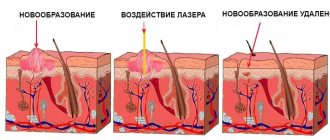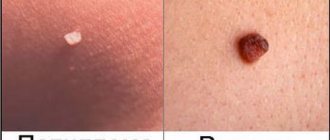Papilloma is a growth on the skin or mucous membrane. Their formation is associated with the human papillomavirus (HPV). Such formations are classified as benign. But there is a risk that in the future they will transform into malignant ones. This disease is widespread and chronic with relapses. There are many different strains of HPV known. They lead to formations of different sizes, shapes, and colors. Papillomas do not hurt or itch, but if placed poorly they cause discomfort or rub.
Are you worried about papillomas on your body? Laser No. 1 for removing papillomas!
Causes of papillomas
The main reason for the occurrence of papillomas on the body is the penetration of a virus into the body. This is often associated with unprotected sexual intercourse. Less commonly, microorganisms enter through small wounds on the skin, during childbirth from mother to baby, as well as during cosmetic procedures and operations. It can take a couple of years from the moment the virus enters the body until formations appear. The fact is that its activity increases greatly when the immune system is weakened.
The rapid growth rate of viral formations may be associated with the following factors:
- Metabolic disorder.
- Chronic gastrointestinal diseases.
- Diseases of the endocrine system.
- Drinking large quantities of alcohol, drugs, smoking.
The development of papillomas can occur in any part of the body, even on the mucous membrane.
Should I get vaccinated against HPV?
Anyone between the ages of 9 and 26 can get the HPV vaccine to protect against genital warts and the various types of HPV that can cause cancer. It is recommended that children be vaccinated between the ages of 11 and 12 so that they are protected several years before becoming sexually active.
This vaccine is not usually given to people over 26 years of age. However, no matter your age, talk to your doctor to find out if the HPV vaccine may benefit you.
to come back to the beginning
Types of papillomas
The most common types of skin formations are:
Regular or vulgar
This is a large papule. At first it is small, as it grows its surface becomes rough. Papilloma does not differ in color from healthy tissue. Several small ones often appear around one wart.
Chords
Papillomas in the form of threads. First, a yellow compaction appears on the skin, which stretches out and acquires a thin stalk. It often forms in the area of the eyelids, neck, and chest.
Flat
Such seals protrude slightly above the body. Outwardly they resemble moles, but are denser in structure. Can form in groups in the genital area, back, anal area
Condylomas
In most cases, a number of papillomas appear in one place, which grow and take on the shape of a “cauliflower”. Locations: labia, vagina, penis.
Warts on the sole
Their main part grows inside tissues and nerve endings, which causes discomfort. The papilloma looks flat and yellow.
Most often, papillomas that are located on the mucous membrane are oncogenic in nature. In any case, if they occur, it is better to consult a specialist.
Radio wave coagulation
Removal of tumors with a radioknife occurs under the influence of directed high-frequency radiation, during which the affected tissue evaporates. The radiotherapy device has several electrodes of various shapes and purposes, which the doctor selects depending on the form of the tumor. The most widely used device in our country is the Surgitron device.
The procedure is performed under local anesthesia in the form of an injection. With this method, papillomas are removed quickly, without damaging healthy tissue, leaving almost no traces. There is no rehabilitation period here, but there are many contraindications to the use of this method. Radioknife is contraindicated for:
- exacerbation of chronic diseases;
- acute inflammatory processes;
- diabetes mellitus;
- pregnancy and lactation;
- presence of a pacemaker;
- oncological diseases of any location.
Radio wave treatment should not be used if there is a possibility of malignancy of papillomas. But in the absence of such, the method is successfully used on any part of the body. According to patients, the most unpleasant thing about this procedure is the anesthetic injection.
Papillomas on the body
Papillomas on the body can occur in the body in various forms. Their size ranges from 1 mm to several centimeters. The rashes can be single or multiple, the color ranges from white to brown.
There are three forms of manifestation of HPV:
- Clinical – papillomas, condylomas, flat formations, warts appear on the skin.
- Subclinical - the appearance of rashes that are not noticeable during a medical examination.
- Latent – there are no symptoms or manifestations. To make a diagnosis, scraping of the epithelium is necessary.
VRF is insidious. Some papillomas can develop into malignant tumors.
Treatment of papillomavirus infection
Papillomas are only a symptom, not a disease.
These symptoms are caused by the papilloma virus.
To prevent formations from reappearing after removal, treatment for papillomavirus infection is required.
It is carried out using:
- immunomodulators
- nonspecific (general action) antiviral agents
The drugs are used both locally and systemically.
They can be injected into the area where papillomas are located.
Systemic immunocorrection is also required.
It is usually performed by an immunologist under the supervision of an immunogram.
After normalization of immunity, the papillomavirus usually leaves the body within several months.
Papillomas on the neck
We are accustomed to calling small nodules with a thin stalk on the neck warts, although in fact they are filiform papillomas. These formations are not life-threatening, but many people want to remove them.
Before removing a papilloma on the neck, you need to make sure that it is not a mole or other skin formation. Its characteristic features:
- The shape of a grain attached to the skin by thin threads, up to 2 mm long.
- Shade - from yellow to brown.
- They can be single (lower on the neck) or grouped up to ten pieces.
- In addition to the neck, papillomas appear on the face, eyelids, cheeks, and around the lips.
Papillomas on the neck appear due to a specific virus that penetrates in different ways - through contact with the skin, transfer to the fingertips.
Electrocoagulation
With any method of removing papillomas, there is a certain rehabilitation period.
It is used to remove small papillomas. Since the essence of the method is the thermal destruction of the affected tissue, the method is popularly called “cauterization.” A heated electrode is used to touch the neoplasm and coagulate it along with the vessels, resulting in a pinpoint burn that becomes covered with a dark crust within an hour. In the case of single papillomas, local anesthesia is used, but in the case of multiple small tumors this is inappropriate.
The rehabilitation period lasts about a week, during which the redness and swelling disappear and the dark crusts disappear. At this time, it is recommended to protect yourself from the sun and treat your skin with an antiseptic.
The use of this method is possible for any location of tumors, and patient reviews indicate its reliability. While the price for removing one papilloma is very reasonable, removing multiple tumors will cost a pretty penny.
Papillomas on the eye
Papillomas can form on the upper and lower eyelids due to the penetration of the papillomavirus. For a long time, the disease may not manifest itself in any way, but its progression can even lead to deterioration of vision. Pathology can take two forms:
- Keratomas are elongated tuberous growths.
- Fibropapillomas are flat formations of various shapes.
Removal of eyelid papilloma is not carried out using a laser; a more preferable option is electrocoagulation.
Resources
There is a lot of information on the Internet about HPV and cancer, but sometimes it is contradictory and unreliable. We recommend contacting the following organizations for further information:
American Cancer Society (ACS) www.cancer.org 800-ACS-2345 (800-227-2345)
Centers for Disease Control and Prevention www.cdc.gov/std/hpv/default.htm
Support for People with Oral and Head and Neck Cancer (SPOHNC) www.spohnc.org 800-377-0928
Return to top
Papillomas in intimate places
In intimate parts of the body, papillomas often appear not one at a time, but several at once, resembling cauliflower. The most popular localization locations:
- pubis,
- groin and perineum,
- scrotum and penis,
- cervix, vaginal mucosa.
In women, papillomas located on the mucous membrane of the vagina or cervix often cause discomfort - itching, pain, bleeding after sexual intercourse, and unpleasant discharge.
Domestic
For internal use, you can use recipes based on dandelion, lemon balm, and medicinal mixtures. Infusions and decoctions are prepared from medicinal plants.
Dandelion
Dandelion herb and root have immunological properties, so the plant can be used internally to stimulate the immune system. How to prepare the infusion:
- chop the grass and dandelion root;
- Pour 1 tablespoon of chopped plant into 150 ml of boiling water;
- leave for 12 hours;
- strain.
The infusion should be taken 50 ml 30 minutes after meals. Dandelion infusion is contraindicated in the presence of diseases of the gastrointestinal tract. In addition, an allergic reaction may develop, so before taking the infusion orally, it is recommended to conduct a sensitivity test.
Dandelions are widely used in folk medicine, including for papillomas
Medicinal collection
For treatment, you can use a collection of several ingredients: lemon balm, nettle and plantain leaves, dandelion root. How to prepare a decoction for internal use:
- take 2 tsp. each plant;
- pour 400 ml of boiling water over them;
- cook in a water bath for 20 minutes;
- strain and let cool.
The decoction should be drunk 3 times a day 30 minutes before meals, 50 ml. The course of treatment is 14 days.
How to remove papilloma (methods)
In cosmetology, there are several methods for getting rid of papillomas in different locations:
- Surgical intervention - recently the technique is losing relevance because it is traumatic.
- Cryodestruction is the removal of tumors using liquid nitrogen.
- Laser removal is the safest and most modern method. Eliminates papillomas without the risk of relapse.
- Electrocoagulation - the procedure is carried out using electric current.
- Radio wave radiation. This technology is similar to laser removal. It not only removes the growth, but also glues the walls of the blood vessels to reduce the rehabilitation period.
Laser removal of papillomas is considered the most popular and safest today.
How does HPV cause head and neck cancers?
We don't know for sure how HPV causes head and neck cancers. Most people with high-risk HPV will not get cancer. However, some people cannot get rid of HPV. In this case, the virus can cause damage that will ultimately cause the development of a tumor. It often takes many years for HPV-infected cells to transform into cancer cells. It is impossible to predict who will clear the infection from their body and who will develop cancer. Most head and neck cancers caused by HPV form in the part of the throat where the base of the tongue and tonsils are located.
to come back to the beginning
Folk remedies for removing papillomas
There are several options for how to remove papillomas at home:
- Cauterize them with celandine juice.
- Apply tea tree oil to the formations every day.
- Make compresses with aloe vera gel. The substance is applied to gauze, which is then applied to the papilloma. Such compresses need to be changed every three hours.
- Constantly wipe the papilloma with a banana peel.
You can use folk remedies only if we are dealing with ordinary papilloma. If it bleeds, causes discomfort or other abnormalities, you should consult a doctor as soon as possible.
Nowadays, there are many methods to remove papilloma. But this does not solve the problem of impaired immune system and metabolism. It is necessary to undergo a full examination to determine the causes of growths and undergo full therapy.
What can I do to avoid getting HPV and spreading it to someone else?
Condoms and dental dams (a thin, rectangular sheet of latex or silicone that covers the genitals of a woman receiving oral sex) are not as effective against HPV as they are against other sexually transmitted infections (STIs), such as chlamydia and immunodeficiency virus. human (HIV), but their use reduces the likelihood of HPV transmission. Always use condoms or dental dams during vaginal, anal, or oral sex.
You should also get vaccinated against HPV and encourage your partner to do the same.
to come back to the beginning










